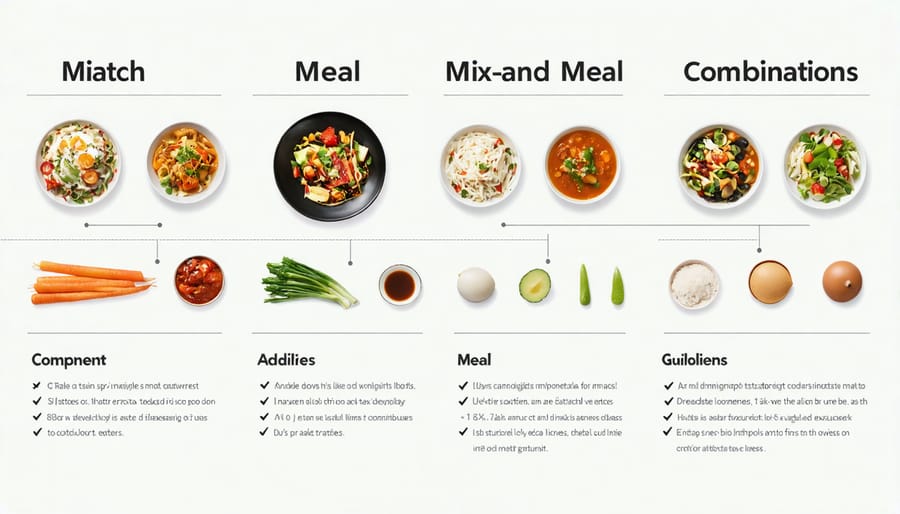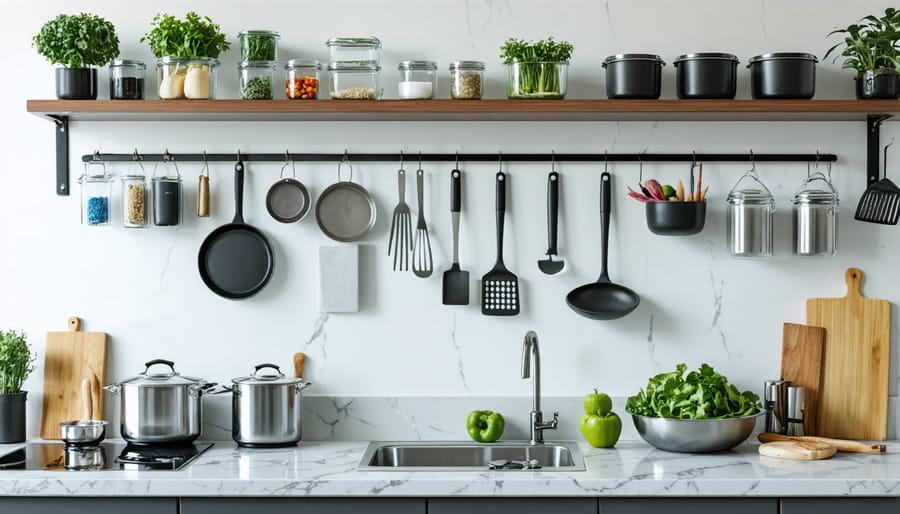
Transform your chaotic weeknight dinner scramble into calm, organized meals with meal prep strategies that work. Picture this: opening your fridge to find perfectly portioned, ready-to-eat meals instead of staring blankly at random ingredients after a long workday.
The secret to successful meal prep isn’t spending your entire Sunday in the kitchen – it’s about smart planning that fits your real life. Whether you’re a busy professional, parent, or both, the right approach can save you hours each week while ensuring you eat well. By dedicating just 2-3 focused hours to preparation, you’ll free up valuable time during your busiest days.
Think beyond basic chicken and rice. Modern meal prep embraces flexible options that adapt to your changing schedule, dietary preferences, and energy levels. With strategic planning and efficient execution, you’ll master the art of preparing delicious, nutritious meals that actually excite you to eat – even during your most hectic weeks.
Ready to revolutionize your relationship with weekday meals? Let’s explore how to make meal prep work for your unique schedule, not against it.
The Mindful Approach to Meal Planning
Realistic Time Assessment
Let’s be honest – we often overestimate how much time we actually have for meal prep. Just like incorporating mindful eating practices, realistic time assessment starts with awareness. Take a week to track your genuine free pockets of time, including those unexpected delays and last-minute commitments that tend to pop up.
Start by identifying your “power hours” – those golden moments when you’re most energetic and focused. For some of us, it’s early Sunday mornings before the kids wake up; for others, it might be Wednesday evenings after work. Look for at least two consistent time blocks of 1-2 hours each week.
Consider your natural rhythm too. If you’re not a morning person, don’t force yourself to prep at 6 AM. Instead, maybe batch cook while catching up on your favorite show in the evening. Remember that meal prep doesn’t have to happen all at once – even 20-minute blocks can be productive if you plan them right.
Keep a simple time diary for a week, noting when you actually cook versus when you thought you would. This reality check helps create a sustainable meal prep schedule that works with your life, not against it.
Setting Sustainable Goals
When it comes to meal prep success, setting realistic goals is your secret weapon. I learned this the hard way when I first started – trying to prep seven elaborate dinners in one afternoon! Now I know better, and I’m here to help you create sustainable goals that actually stick.
Start small by choosing just 2-3 meals to prep each week. This approach helps you build confidence without feeling overwhelmed. Consider your typical week: Are Wednesdays always crazy with after-work commitments? That’s your cue to prep Wednesday’s dinner in advance.
Think about your food preferences and schedule patterns. If you know you won’t eat the same lunch five days in a row, plan for variety with mix-and-match components instead. Maybe prep different proteins and veggies that can be combined in various ways throughout the week.
Set specific, measurable goals like “prep three healthy lunches every Sunday” rather than vague objectives like “eat better.” Remember, your meal prep routine should flex with your life – not the other way around. As you build confidence, gradually expand your prep sessions based on what actually works for you.
Smart Prep Strategies That Save Hours
The Power Hour Method
I call it the Power Hour Method, and it’s been a game-changer for my meal prep routine. Think of it as your weekly meal prep sprint – one focused hour that sets you up for success all week long. Trust me, when you approach this hour with intention, it’s amazing what you can accomplish!
Start by setting a timer for 60 minutes – this creates a sense of purpose and helps maintain momentum. Begin with your most time-consuming tasks, like chopping vegetables or cooking grains. While those items are cooking, move on to preparing protein sources and portioning out snacks. I’ve found that having multiple tasks running simultaneously is key to maximizing this precious hour.
Here’s my tried-and-true sequence: First 15 minutes for washing and chopping vegetables, next 20 minutes for cooking proteins and grains (while continuing to prep other ingredients), 15 minutes for assembling containers and portioning, and the final 10 minutes for cleanup and organization.
The secret to making the Power Hour work is preparation. Before you start, have all your containers ready, your recipe plan set, and your ingredients laid out. Think of it as setting up your workspace for maximum efficiency. Keep a simple checklist on your phone or refrigerator to make sure you’re hitting all your prep goals within the hour.
Remember, this isn’t about perfection – it’s about progress. Some weeks you might prep more than others, and that’s perfectly okay. The Power Hour Method is flexible enough to adapt to your changing schedule while still ensuring you have healthy meals ready to go.
Batch Cooking Basics
Transforming your kitchen into a meal prep powerhouse starts with mastering the art of batch cooking. Think of it as your secret weapon for healthy cooking success throughout the week. I remember when I first started batch cooking – it felt overwhelming until I broke it down into manageable steps.
Start by selecting 2-3 protein options that can work in multiple dishes. While your chicken breasts are roasting, you can simultaneously steam rice and roast mixed vegetables on another rack. This multi-tasking approach is the heart of efficient batch cooking.
Pro tip: Use your oven’s real estate wisely. While roasting proteins on one shelf, fill another with sheet pan vegetables tossed in olive oil and seasonings. The beauty of this method is that everything cooks at around the same temperature (375°F/190°C).
Components to batch cook in one session:
– Proteins (chicken, fish, or legumes)
– Grains (rice, quinoa, or pasta)
– Roasted vegetables
– Sauces or dressings
– Hard-boiled eggs
The key is choosing items that maintain their quality when stored properly. Most cooked components last 3-4 days in the refrigerator, giving you building blocks for various meals throughout the week. Remember to let everything cool completely before storing – this prevents condensation and keeps your food fresher longer.

Mix-and-Match Components
Let me share a game-changing approach that’s transformed my meal prep routine: the mix-and-match method. Think of it as creating a wardrobe for your meals, where different pieces work together beautifully. Instead of preparing complete meals, focus on cooking versatile components that can be combined in various ways throughout the week.
Start with three main categories: proteins, grains/starches, and vegetables. For proteins, consider grilling chicken breasts, baking salmon fillets, or preparing a batch of seasoned lentils. With grains, cook quinoa, brown rice, or roasted sweet potatoes. For vegetables, roast a colorful medley of bell peppers, broccoli, and carrots, or prepare fresh greens for salads.
The magic happens when you mix these components. Monday’s grilled chicken with quinoa and roasted vegetables can transform into Tuesday’s chicken quinoa bowl with different seasonings. Wednesday might feature a salmon salad using your prepped greens, while Thursday’s dinner could be a warm grain bowl with lentils and roasted vegetables.
Keep things interesting by preparing two or three options from each category and storing them separately. Add variety with different sauces, dressings, and seasonings – I always keep pesto, tahini dressing, and lemon vinaigrette ready to go. This approach not only saves time but also prevents meal fatigue, giving you the flexibility to create diverse, satisfying meals even during your busiest days.


Kitchen Setup for Success
Must-Have Time-Saving Tools
Having the right essential kitchen tools can make the difference between dreading meal prep and breezing through it like a pro. I’ve learned this the hard way after countless Sunday afternoons spent chopping vegetables with a dull knife!
Start with a high-quality chef’s knife and at least two cutting boards (one for produce, one for proteins) to maintain food safety. A set of glass containers in various sizes is non-negotiable – they’re perfect for portioning and storing your prepped ingredients and completed meals.
My game-changers include a food processor for quick chopping and shredding, an Instant Pot for hands-off cooking, and a quality set of measuring cups and spoons. If budget allows, invest in a vacuum sealer to extend the freshness of your prepped ingredients.
Don’t forget the basics: a reliable peeler, multiple mixing bowls, and sheet pans for roasting vegetables. I also swear by my collection of mason jars – they’re perfect for overnight oats, salads, and storing homemade dressings.
Storage Solutions
Let’s talk storage – it’s the unsung hero of successful meal prep! I learned the hard way that all those hours of chopping and cooking can go to waste without proper storage solutions. The key is investing in quality containers that work for your lifestyle.
Glass containers with snap-locking lids are my go-to for most prepared meals. They’re perfect for reheating, don’t retain odors, and let you see exactly what’s inside. For busy parents juggling multiple schedules, I recommend getting sets in different sizes – portion control becomes so much easier!
Mason jars have become my secret weapon for prepped ingredients and layered salads. They keep everything fresh and are perfect for grab-and-go situations. Pro tip: store your cut vegetables with a paper towel to absorb excess moisture and extend freshness.
Don’t forget to label everything! A simple piece of masking tape with the date and contents can save you from playing “guess what’s in this container” later. I like to organize my fridge with the oldest items in front, using clear bins to keep similar items together. This system has been a game-changer for reducing food waste and keeping track of what needs to be used first.
Mindful Meal Prep in Action
3-Day Sample Plan
Let me walk you through a realistic three-day meal prep plan that I’ve found works wonders for busy weeks. We’ll prep everything on Sunday, taking about 2-3 hours total, and you’ll be set for the week ahead!
Day 1:
– Breakfast: Overnight oats with berries and nuts (prep 4 jars)
– Lunch: Mediterranean quinoa bowls with grilled chicken
– Dinner: Sheet pan salmon with roasted vegetables
– Snacks: Cut vegetables with hummus
Day 2:
– Breakfast: Greek yogurt parfait with homemade granola
– Lunch: Leftover quinoa bowls
– Dinner: Turkey meatballs with zucchini noodles
– Snacks: Apple slices with almond butter
Day 3:
– Breakfast: Overnight oats (from Sunday prep)
– Lunch: Mason jar salads with chickpeas
– Dinner: Leftover turkey meatballs
– Snacks: Mixed nuts and dried fruit
Sunday Prep Steps:
1. Start with quinoa and chicken in separate pots
2. While those cook, prepare overnight oats
3. Chop all vegetables for the week
4. Make turkey meatballs
5. Portion everything into containers
Pro tip: Keep sauces separate and add fresh ingredients like avocado just before eating. This plan is flexible – feel free to swap meals around based on your schedule and preferences. The key is having everything ready to grab and go!
Troubleshooting Common Challenges
Even the most organized meal preppers face challenges, but don’t worry – I’ve been there, and there’s always a solution! When ingredients spoil before you use them, try planning just 3-4 days ahead instead of a full week. I learned this the hard way after throwing out too many wilted greens!
Storage problems? Been there too! Invest in quality containers that stack well and save space. I love using mason jars for salads and clear containers that let me see what’s inside – it’s amazing how this simple switch can transform your fridge organization.
Feeling bored with repetitive meals? Mix and match your prepped components differently each day. Those roasted vegetables can be a side dish one day and part of a grain bowl the next. Add different sauces or dressings to transform the same basic ingredients into entirely new meals.
When time gets super tight, remember that not everything needs to be cooked from scratch. There’s no shame in combining pre-cut vegetables with rotisserie chicken or using canned beans. The goal is progress, not perfection!
Food fatigue hitting hard by Wednesday? Prep base ingredients rather than complete meals. This way, you can assemble different combinations throughout the week while still saving time. Trust me, having cooked quinoa and roasted vegetables ready to go is a lifesaver on busy days!
Remember, meal prep should make your life easier, not more stressful. If something isn’t working, adjust your approach until you find your groove.
As we wrap up our meal prep journey together, remember that taking control of your weekly meals isn’t about achieving perfection – it’s about creating a sustainable system that works for your unique lifestyle. By implementing the strategies we’ve discussed, from smart planning to efficient batch cooking, you’re already on your way to transforming your relationship with food and time management.
Start small by choosing just two or three meals to prep each week, and gradually build up as you become more comfortable with the process. Remember that even preparing basic ingredients in advance, like chopped vegetables or portioned proteins, can make a significant difference in your daily routine.
The beauty of meal prep lies in its flexibility – there’s no one-size-fits-all approach. Whether you prefer dedicated Sunday prep sessions or break it up into smaller tasks throughout the week, what matters most is finding your rhythm and sticking to it.
As you begin this journey, be patient with yourself and celebrate the small wins. Notice how meal prep not only saves you time and reduces stress but also helps you make healthier choices naturally. Your future self will thank you for taking this step toward a more organized, mindful approach to nourishing yourself.
Ready to get started? Choose one strategy from this guide and implement it this week. Remember, every meal prep master started exactly where you are now – with a single step forward.



